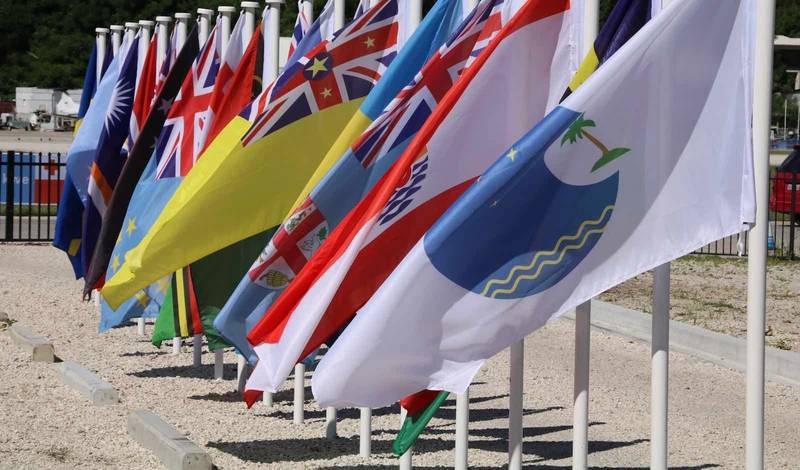United Nations Secretary-General Antonio Guterres said on Tuesday that ocean temperatures are rising in the Pacific Islands at three times the rate worldwide, and its population was “uniquely exposed” to the impact of rising sea levels.
Speaking to reporters in Tonga where the Pacific Islands Forum is being held, Guterres highlighted the findings of a report that showed the South West Pacific was worst hit by sea level rises, in some places by more than double the global average in the past 30 years.
“I am in Tonga to issue a global SOS – Save Our Seas – on rising sea levels,” he said.
“Rising seas are amplifying the frequency and severity of storm surges and coastal flooding. These floods swamp coastal communities. Ruin fisheries. Damage crops. Contaminate fresh water. All this puts Pacific Island nations in grave danger,” he said.
Water expands as it warms, contributing to sea level rise, he said.
Climate change and security are dominating discussions at the week-long annual leaders meeting, where the 18 members of the Pacific Islands Forum span atoll nations threatened by sea level rise such as host Tonga, and one of the world’s biggest exporters of coal, Australia.
Asked by a reporter about Australia’s export of fossil fuels, Guterres said fossil fuels must be phased out globally, although “the situation in different countries is different” and there would be different ways to do this.
The report released on Tuesday by the World Meteorological Organization showed ocean temperatures in the South West Pacific are increasing at up to three times the rate worldwide.
“Pacific islands are uniquely exposed. This is a region with an average elevation just one to two metres above sea level,” Guterres said.
“Half the infrastructure is within 500 metres of the sea,” he added.
Without cuts to global emissions, the Pacific Islands can expect additional sea level rise of 15 cm (5.9 inches) by 2050 and 30 days a year of coastal flooding, he said.
He called for global leaders to “massively boost climate adaptation investments” in vulnerable countries.
A “loss and damage” fund to help poor nations cope with costly climate disasters was approved at last year’s U.N. climate summit, after years of lobbying by groups including the Pacific Islands, but the challenge remains to attract significant contributions to the fund from wealthier nations.
“Developed countries must deliver on their finance commitments – including the commitment to double adaptation finance to at least $40 billion a year by 2025,” Guterres said.
More from Tonga
Sea level rises in the Pacific Ocean are outstripping the global average, a World Meteorological Organization (WMO) report showed on Tuesday, imperiling low-lying island states.
Globally, sea level advances are accelerating as higher temperatures driven by the continued burning of fossil fuels melt once-mighty ice sheets, while warmer oceans cause water molecules to expand.
But even compared to the global average rate rise of 3.4 millimetres a year over the past three decades, the WMO report showed that the average annual increase was “significantly higher” in two measurement areas of the Pacific, north and east of Australia.
“Human activities have weakened the capacity of the ocean to sustain and protect us and – through sea level rise – are transforming a lifelong friend into a growing threat,” said WMO Secretary-General Celeste Saulo in a statement to coincide with the release of the regional State of the Climate report 2023 at the forum in Tonga.
Already, such rises have brought a surge in the frequency of coastal flooding since 1980, with dozens of instances happening in islands like the Cook Islands and French Polynesia which previously reported just a handful of such cases annually.
Such events are sometimes caused by tropical cyclones which scientists think could also be intensifying due to climate change, as sea surface temperatures climb.
Over 34 hazards like storms and floods were reported in the Pacific region in 2023, resulting in more than 200 deaths, the WMO report said, adding that only a third of small island developing states had early warning systems.
A WMO spokesperson said that the impact of rising water levels on Pacific islands was disproportionately high since their average elevation is just a meter or two (3.3 to 6.5 feet) above sea level.
To raise awareness of the dangers, Tuvalu’s foreign minister gave a speech to the U.N. climate conference in 2021 while standing knee-deep in seawater, making global headlines.
But the WMO report said further rises across the planet would “continue for centuries to millennia due to continuing deep ocean heat uptake and mass loss from ice sheets”.
(Reuters – Reporting by Emma Farge, Editing by William Maclean, Additional reporting by Kirsty Needham; Editing by Stephen Coates)

